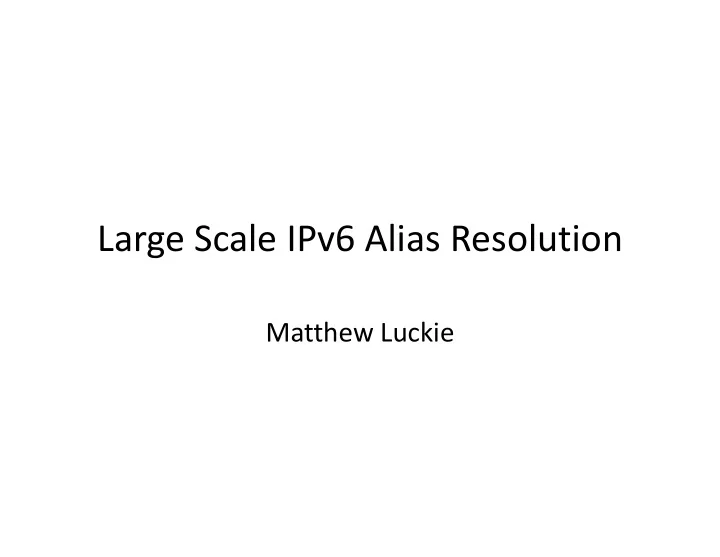

Large Scale IPv6 Alias Resolution Matthew Luckie
Overview • IP-ID based alias resolution techniques – IP-ID used in reassembly to identify fragments that belong to same packet. – Commonly implemented as a counter in IPv4 (and v6) – ally ally – radargun / midar • Problems applying TBT to large-scale alias resolution ~9000 interfaces in set with incrementing IP-ID • • Current status
Overview – Ally • Pairwise testing of candidate aliases. – Does not scale well, but useful to cross validate earlier measurements or confirm near-certain aliases aliases • Given interfaces X and Y – probe X, then Y, then X, then Y, then X – If an incrementing sequence of IP-ID values is returned, likely aliases.
Overview – Radargun / MIDAR • Probe all interfaces in parallel and compute aliases offline. • Radargun – aliases have similar velocities and IP-ID distance is – aliases have similar velocities and IP-ID distance is within a fudge factor • MIDAR – (a lot of algorithm to scale to millions of interfaces) – aliases return monotonically incrementing IP-ID values from non-overlapping probes
Issues applying Radargun / MIDAR with IPv6 • Need to periodically send router PTBs so it will send fragments with IP-ID • Need to solicit large responses so the router will fragment will fragment – IPv6 min MTU: 1280 bytes. – IPv4 probes are typically < 40 bytes • i.e. 30x smaller – Can solicit atomic fragments. TODO item.
10 mins 2 hours
First attempt at radargun prober • Send PTBs whenever a packet is received without a fragmentation header – Do not re-probe address – Original probe considered ‘lost’ • 30 one-min rounds • 1300 byte ICMP echo request packets • i.e. 300 x 1300 byte pps (390,000 bps) – Much higher data rate than if we sent small probes
72% of IP-ID values between 127 and 1000 not a lot of entropy for a 32 bit number
30 Very little velocity in IP-ID counter over a 30 minute period 30 rounds – shouldn’t there be bands at increments of 30?
Received responses to half of probes for most addresses!
Second attempt • Lack of entropy in IP-ID further motivates sequence of non-overlapping probes / responses. • 10 one-min rounds • 10 one-min rounds – each round with probe order shuffled
Results • 2492 pairs with incrementing, non- overlapping IP-ID values • Probed with ally, 5 probes, 1 sec intervals: – 14 not aliases: 0.6% of pairs 14 not aliases: 0.6% of pairs • Rejected with very close IP-IDs, often the same value – 173 packet loss (no classification): 7% of pairs • Another attempt would enable these to be classified. – 2305 aliases: 92.5% confirmed • 910 routers, 90% of them with two observed aliases
Reducing packet loss / data rate • Probe with larger windows? – Relies on remote system caching PTB – Tried a window of 3 minutes but had half as many candidate aliases. i.e. performed worse. • Need to spend time in data figuring out why • We have ideas for smarter probing given extremely low IP-ID velocity – Need to implement and evaluate them.
Applications to IPv4 • http://datatracker.ietf.org/doc/draft-ietf- intarea-ipv4-id-update/ – Would set IP-ID value only when the packet is fragmented fragmented • Do IPv4 routers that set a constant IP-ID value set a non-constant IP-ID if they have to fragment the response?
Summary • Not trivial to re-apply IPv4-based IP-ID alias resolution techniques. – Data rate required in IPv6 much larger – Need to solicit fragments Need to solicit fragments • Need to try alternative methods: UDP and TCP – UDP will require router to accept an ICMP error (PTB) for another ICMP error (port unreach) – Both rely on atomic fragments because responses <= 1280 bytes.
Recommend
More recommend